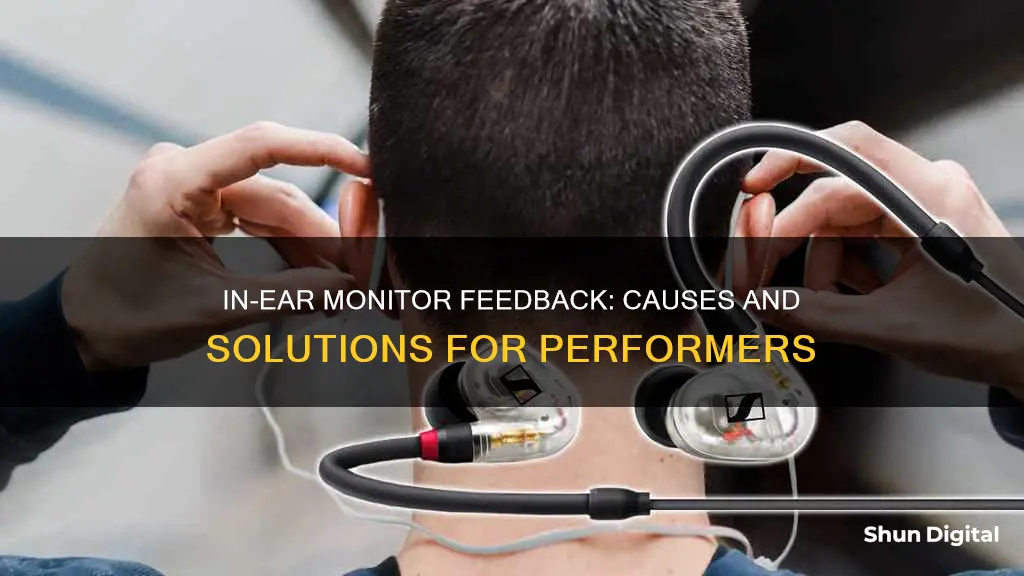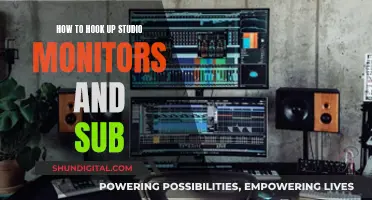
In-ear monitors (IEMs) are becoming increasingly popular among musicians, offering a range of benefits over traditional stage monitors. However, one concern that musicians may have when considering the switch to IEMs is the potential for feedback issues. Feedback occurs when an output signal, such as from a speaker, is routed back into an input signal, such as a microphone. This can result in a loud, unpleasant noise that can be damaging to the ears and disruptive to a performance.
| Characteristics | Values |
|---|---|
| Microphone type | Directional microphones such as cardioid or hypercardioid are less susceptible to feedback than omnidirectional microphones. |
| Microphone placement | For cardioid mics, place the stage monitor directly behind the mic. For hypercardioid mics, point the stage monitors to the sides of the mic. |
| Monitor mix | A good monitor mix can reduce feedback. |
| Gain | Ensure the gain is not too high, as this can cause feedback. |
| Frequency | Identify and cut the specific frequencies causing feedback by using an EQ or a spectrum analyzer. |
| Volume | Keep the volume at a reasonable level to avoid feedback and hearing damage. |
| Limiter | Use a limiter in the IEM pack or on the output bus to prevent excessive volume and feedback. |
| Headroom | Minimize headroom on the output to reduce the difference between nominal and maximum signal levels, thereby lowering the potential volume of feedback. |
| Stage volume | In-ear monitors help reduce overall stage volume, which can cause feedback and disturb performers. |
What You'll Learn

Microphone placement
Directional or cardioid microphones are recommended, as they only pick up sound from what they are pointed at. An omnidirectional microphone, on the other hand, captures audio from every angle and is therefore more prone to feedback. If it is not possible to place the speakers in front of the microphone, increasing the distance between the microphone and the speakers can help reduce feedback.
Additionally, keeping the audio source close to the microphone is important. If singing or speaking, hold the microphone directly in front of your mouth so it only picks up your voice instead of the noise around it. For instruments, place the microphone as close as possible so it doesn't pick up a lot of feedback from other sources.
The placement of speakers in relation to the microphone is also key. Speakers should be pointed towards people or the crowd, rather than walls, ceilings, or windows, to avoid sound bouncing off flat surfaces and re-entering the microphone.
Finding Monitor Serial Numbers: Command Prompt Tricks
You may want to see also

Stage monitor placement
Microphone and Monitor Placement
The placement of microphones and monitors should be carefully considered to minimise feedback. It is recommended to position microphones for maximum rejection in the direction of stage monitors. For cardioid microphones, the stage monitor should be placed directly behind the mic, as they are most effective at rejecting sound from directly behind. For hypercardioid microphones, place the stage monitors so they are pointed at the sides of the mic to utilise the rejection on the sides.
Additionally, keep each mic as close to its source as possible to reduce stray signals and the need for added gain at the mixing desk. Separating signal sources also helps the mic to pick up its intended voice or instrument with minimal leakage.
Monitor Mixes and EQ
Monitor mixes are essential in reducing feedback and improving sound quality. It is crucial to understand the directionality or polar pattern of the microphones used and to properly tune the monitors with an EQ. To do this, maximise the gain until feedback occurs, then use a graphic EQ to identify and reduce the problematic frequencies.
A 31-band, "third octave" graphic EQ is commonly used, allowing for precise control over specific frequencies. When cutting unwanted frequencies, be mindful not to cut too much, as this can negatively impact the sound quality of the monitors.
Volume Control
Keep the stage volume at a minimum comfortable level to reduce sound waves bouncing off walls and other surfaces, which can cause feedback.
By following these instructions and optimising stage monitor placement, you can effectively reduce feedback and improve the overall sound quality of the performance.
Verizon's Hotspot Usage Monitoring: What You Need to Know
You may want to see also

Poor gain staging
Gain staging is the process of managing input gains and output levels. To achieve the best sound, you must strike the right balance between the two. Correct gain staging ensures that your music will be free of excess noise and distortion, while improper gain staging can result in a sound that’s lifeless, muddy, or hard to hear.
The term "gain" refers to the strength of a signal coming into a device, while "level" refers to the strength of the signal leaving a device. In other words, gain denotes input signal, and level denotes output signal. A "stage" refers to any point where you can control the input gain or output level of a device. Examples of audio "devices" include microphone preamplifiers, powered speakers, outboard signal processors, plug-ins, and the inputs, faders, and buses of a mixing console.
To achieve proper gain staging, you must introduce as little noise as possible. This means minimizing any unwanted sound in your signal, such as the low-level hum and hiss inherent to electronic circuitry or an onstage microphone that is too far from the vocalist or instrument it is trying to pick up.
- Utilize metering, which provides a graphical representation of volume levels at each stage. Look for meters that use a color-coding system, such as green for the presence of a signal, yellow for levels approaching clipping, and red for clipping.
- Aim for unity gain, which means that the device is neither attenuating nor boosting the signal and is having minimal effect on volume.
- When applying EQ, be aware that each frequency band is its own gain stage. Cutting is generally better than boosting, as it won't overload the gain structure and will decrease noise in the selected frequency band.
- Use high-pass filters on your channel strips to cut out low-frequency information that you don't need, such as stage rumble from mic stands or handling noise and wind.
- Ensure that your monitoring levels are moderate, and that your gain staging is correctly set.
By following these guidelines, you can avoid poor gain staging and minimize the risk of feedback in your in-ear monitors during live performances.
Removing Super Glue from Your Monitor: Effective Strategies
You may want to see also

Lack of noise isolation
In-ear monitors (IEMs) are a special category of headphones used by live performers. They deliver sound through tiny earpieces that fit into the ear canal, creating a barrier to outside noise. IEMs can offer 20-40dB of noise reduction, with some models offering up to 37dB of sound attenuation.
A lack of noise isolation can cause feedback in IEMs, as external noise can interfere with the sound being delivered through the earpieces. This can be a problem for performers who need to hear their own performance without any interference from outside noise.
IEMs with noise isolation ensure that musicians hear a consistent and precise mix, allowing them to deliver the best possible live performance. Noise isolation also gives artists the freedom to move around the stage without worrying about feedback or external noise interference.
There are several ways to improve noise isolation in IEMs. One way is to use foam or silicone ear tips, which can block out external noise and create a seal in the ear canal. Foam ear tips tend to be denser and more isolating than silicone tips, but they can be uncomfortable for some people and don't handle sweat well. Silicone tips, on the other hand, use suction to stay in place and are often preferred by active performers.
Another way to improve noise isolation is to invest in custom-made IEMs. These are moulded to the individual's ear canal, providing a perfect fit and optimal noise isolation. Custom-fitted IEMs were first created for drummer Alex Van Halen, who needed a way to hear his bandmates amid overwhelming stage noise.
Additionally, the number of drivers in IEMs can also affect noise isolation. Higher-end IEMs can have up to eight drivers per earpiece, which distributes the workload more broadly and allows each driver to function more optimally. This can result in a wider dynamic range and improved frequency response, reducing the risk of feedback.
Overall, achieving optimal noise isolation in IEMs is crucial for live performers to ensure a consistent and precise listening experience on stage.
Tethering Usage: Monitor Your T-Mobile Data Like a Pro
You may want to see also

Poorly fitting earpieces
To prevent this, it's important to ensure a proper fit for the earpieces. This can be achieved through custom-molded earpieces that are designed specifically for an individual's ears, providing an airtight seal. While custom-molded earpieces can be more expensive, they offer a more comfortable and secure fit, reducing the chances of feedback. Another option is to use generic earpieces with various tips that can be adjusted to fit the ear canal better.
Additionally, the shape and size of the pinna (outer ear) can also impact the fit of earpieces. Individuals with larger, curved pinnae may experience more slit leakage, as the sound can be reflected back to the microphone. In such cases, modifying the shape of the earpiece or using build-up materials to create a tighter seal may be necessary.
It's worth noting that even with well-fitting earpieces, feedback can still occur due to other factors such as high gain settings, the proximity of the microphone and receiver, or the acoustics of the venue. However, ensuring a proper fit is a crucial step in minimizing the chances of feedback during live performances.
Understanding Acer LCD Monitors: The ACM Advantage
You may want to see also
Frequently asked questions
Feedback occurs when an output signal (e.g. a speaker) is routed back into an input signal (e.g. a microphone). In the context of in-ear monitors, this could happen if a singer points a mic at a floor monitor.
To prevent feedback, it's important to understand the directionality of the microphone being used and to properly tune the monitors with an EQ. Microphones with a directional pickup (cardioid or hypercardioid) are commonly used by vocalists. When placing the stage monitor, ensure it is directly behind a cardioid mic or pointed at the sides of a hypercardioid mic to minimise feedback.
In addition to proper microphone placement and tuning, you can use a limiter in the in-ear monitor pack or on your mixer. This will prevent the volume from exceeding a certain level and causing feedback. You can also try to minimise the headroom on your output, sacrificing flexibility in gain staging to reduce the difference between nominal and maximum signal levels.







